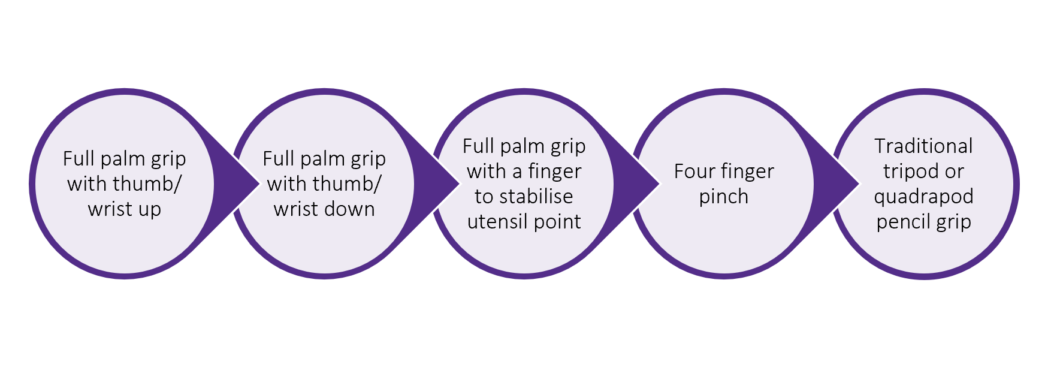Preliminary writing skills, often referred to as pre-writing skills, are the foundational literacy and motor skills children need to develop before learning to write. You might be surprised that learning to write doesn’t start with letters, but rather much, much earlier, from when your child is able to move independently. In this blog we’ll discuss the vital preliminary writing skills children need to develop before writing, including gross motor skills, fine motor skills, hand muscles, stamina and pencil grip.
Preliminary Writing Skills – Gross Motor Development
To be able to learn to write, children need to have well developed gross motor control in order to advance their fine motor skills. They key parts of children’s gross motor development related to writing are having good seated posture which comes from stable core control, bilateral coordination, hand-eye coordination, midline crossing and hand dominance.
Having good seated posture is important for writing, as without it, children will tire easily, increasing their frustration and making it difficult for them to focus on the task at hand. Crossing the midline, or the imaginary line that bisects the body, separating it into the left and right sides, is something that takes children time to become comfortable with, and goes hand in hand with developing a dominant hand. This skill is important for writing as children will eventually be writing on the left side of the page with their right hand, or vice versa.
Bilateral coordination is particularly pertinent from early on in a child’s writing journey, as they’ll need to be able to stabilise the material they are writing on, like their piece of paper, with one hand, whilst manipulating their writing instrument with the other. Hand-eye coordination is also required, as they eyes are used to guide and direct hand movements in conjunction with muscular control.
Children start building their gross motor skills from when they are born, and this development continues throughout childhood. The majority of gross motor development happens through free play, where children are spending time moving around for the joy of it. For ideas on how to support your little one’s gross motor development, check out the physical play and nature play sections in our blog on the Key Types of Play for Children’s Development.
Preliminary Writing Skills – Fine Motor Development
Before even thinking about your child holding a writing utensil, it is important that they build up their fine motor skills, hand muscles and dexterity first. This will ensure it is a positive experience, as without these, their hand muscles will be weak and lacking in control, which leads to strain and fatigue, making any kind of drawing or writing less enjoyable.
Solid fine motor control helps to prepare children for drawing, writing, painting, cutting, tying shoes, colouring, buttoning and doing up zips, among many other skills. Here are some activities you can try to help develop your child’s fine motor skills.
Fine Motor Activities for Children
Lacing and Threading Activities
- Lacing large beads or rings onto a dowel
- Lacing large beads onto a pipe cleaner
- Lacing large beads on a string
- Lacing small beads on wire
- Lacing pasta on a string
- Lacing small beads on a string
Pinching Activities
- Incorporating small food items into meal or snack times, like popcorn, cheerios or other cereal, or peeling a string cheese stick to encourage a pinching grip
- Peeling and sticking stickers (start with puffy stickers, which are easier to grasp and move onto flat stickers)
- Using eye droppers, for example in water play
- Tearing up paper (you can use it to make a collage artwork afterwards)
- Playdough
- ‘Posting’ activities where items have to be placed into a slot, like a coin box, or a play letter box (which are super simple to make out of an old shoe box by cutting a slot in the lid)
- Puzzles, particularly ones that have knobs on the pieces
- Sticking masking tape or painters tape to the wall for your child to pull off
- Putting pegs on a shirt or even a length of ribbon, fabric, carboard or paper
Utensils for Preliminary Writing Skills
The single most important way to incorporate writing implements into your child’s play is to offer a variety of utensils. For children who are just beginning, larger utensils are perfect, like egg-shaped crayons, large thick-handled paintbrushes, jumbo crayons and sidewalk chalk sticks.
Once your child has mastered and is comfortable with these, you can introduce smaller and thinner implements, like traditional pencils, smaller paintbrushes and crayons. Practice here is key – the more your child uses different utensils, the more stamina they’ll develop.
The Progression of Pencil Grip
The way a child grips a writing utensil will progress as they develop the hand muscles and control to manipulate it more effectively without needing so much stabilisation.

The progression through the first four stages of a pencil grip usually happens quite naturally, however many children have trouble moving from a four finger pinch to a traditional pencil grip, often because their fingers are spread out along the length of the utensil to stabilise it.
Having the fingers condensed is the most important element to transitioning to tucking the fourth and fifth fingers. To encourage a more effective writing grip, providing children with shorter utensils is important as it encourages them to move their fingers closer together.
Most importantly, keep things fun! The more a child enjoys an activity, the more often they’ll want to do it, and as practice and repetition are the key to developing preliminary writing skills, keeping your child engaged and excited about it are paramount. With a solid foundation of gross motor and fine motor skills, children will be able to use writing implements with confidence to enable them to make the transition to writing specific shapes when they are developmentally ready.



